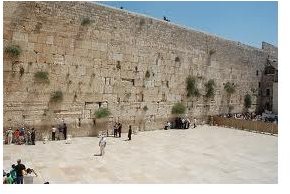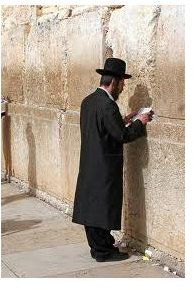Traditional Clothing of Israel: Attire for Men and Women
Israel, a Combination of Antiquity and Modern Cultures
You can expect that in Israel, styles of antiquity, modern attire and traditional religious dress combine. Israel, one of the most powerful and Westernized nations in the Middle East, serves as a tapestry of old and new culture. The Jewish religion is dominant, yet it embodies several sects, adding to the cultivation of custom and tradition.
Ancient ways are still revered. New customs and mannerisms are accepted. The country of Israel collides with the nations that surround her, yet she remains solid and commanding. From military ware to Hasidic tendrils, the world combines most of its cultures in this tiny land.
Three Influential Sects of Judaism
From the 2011 Israeli census, it is estimated that 5.8 million of the 7.75 million people who populate Israel are Jewish.
There are many sects of Judaism, each adding to the culture of Israel. Orthodox, Conservative and Reform Judaism are differentiated by their approach to Jewish Law. Orthodox Judaism adheres strictly to Judaic Law presented in the Torah (the first five books of the Old Testament). Orthodox Jews consider the Torah and Jewish Law to be divinely inspired.
Reform and Conservative Judaism sects are more liberal in their approach to Jewish Law. They see these rules as guidelines rather than restrictions. Jewish Law dictates most sections of Judaic culture including dress, food and conduct.
Hasidic or Hasidism is a branch of the Orthodox Jewry. Hasidism is a collective philosophy of individual sects of Judaism and mysticism. Founded in the 18th century in Eastern Europe by Rabbi Israel bal Shem Tov, Hasidism incorporates the divinity of Jewish Law with mystical thought. Hasidism tradition is conservative in dress, philosophy and adherence to Jewish Law.
Jerusalem, Home to the World’s Religions, Customs and Traditions

The United Nations declared Israel an independent nation on May 14, 1948. In this relatively short period of time, Israelis have been in multiple border disputes and wars with their neighboring Arab nations. Peace treaties with Egypt and Jordan have helped establish perimeters with occupied territories, yet complications with Palestinians have continued to this date.
A developed country with a representative democracy and parliamentary system, Israel is the most Westernized country in the Middle East. Jerusalem serves as the nation’s capital, although it is not internationally recognized. Tel Aviv is acknowledged as the political and financial capital of Israel by most of the world.
Jerusalem, one of the world’s oldest cities, plays a central role in the world’s three major religions; Judaism, Islam and Christianity. Muslims worship at the Al-Aqsa Mosque. Christians claim the grounds of Jesus Christ’s birth, life and death. The Jewish people recognize Jerusalem as their “home land.”
Jerusalem attracts more pilgrims than any other city in the world. Tourism has brought Western culture into the Biblical city.
Traditions, pageantry, prayer, customs and cultures are mixed in this tiny city. Although considered the holiest of sites, Jerusalem experiences eruptions of violence due to the conflicts of the major religions.
Israel’s Climate and Religions Influence Dress
Temperatures vary in the desert land of Israel. Winters can be harsh with snowfall up to a few inches in Jerusalem per year. Coastal cities, such as Tel Aviv and Haifa, have Mediterranean climate with cool, rain-filled winters and hot summers. The southern regions of Israel are desert climate cultures with temperatures well over 100 degrees Fahrenheit.
For most Israelis, dress is attributed to the climatic conditions of the territories. Many Israelis obtain two wardrobes, one more Westernized and suited for such severe climatic fluctuations, and the other to reflect the dominant religion.
Light clothing of linen, flax and cotton are commonly worn in the desert regions. White reflects the sun’s rays and keeps the people of this harsh-climed land cool. Traditional attire in Israel is similar to western style.
Orthodox and Hasidic Jews commonly dress according to Jewish Laws. Modesty and dark colors reflect the conservative nature of the Laws. Reform and Conservative Jews are more likely to adhere to Western garb during working hours, changing into traditional Jewish dress during holidays and the Sabbath.
Traditional Israeli Women’s Attire

Tznius clothing (Hebrew for modest attire) is essential for Hasidic and Orthodox Israeli women. The female is to be revered for her introspection and devotion to God, not her physical form.
Most colors are subdued with little pattern in the fabric. Tops are high at the neck and long-sleeved. Skirts are often chosen over pants. Skirts provide extra fabric that does not accentuate the woman’s physical form.
According to Jewish Law, only the face and hands should be exposed. Most Orthodox women wear tights or leggings under the dress. During Jewish celebrations, Israeli women will be covered from head to toe.
Swim apparel is especially designed to cover the body without revealing the curvatures of the form. Stylists create swim fashions that cover the arms to the elbow and the thighs to the knee. For ultra-conservative Orthodox Jewish women, tights will be worn under the suit.
As part of the modest tradition of tznius, women often wear a scarf or wig. The tichel (Yiddish for kerchief) is often worn tight to the skull and tied at the nape of the neck. The long fabric flows down the back.
Some Hasidic women will shave their own hair before donning a wig or the tichel. The practice is not based on Jewish Law or Biblical teaching, but believed to be a convenience. A sheitel, or wig, may be worn in lieu of the tichel. The sheitel is worn by married Orthodox or Hasidic women.
Small sects of Hasidic women shave their heads the night before their wedding. Before the Mikveh or ritual immersion, every part of the body including all tresses must be submerged. It is believed that shaving the head makes the practice more convenient.
Conservative Israeli Dress for Men

Modesty is also important to Orthodox and Hasidic men when it comes to dress. Most men in these Jewish sects wear black jackets, pants and shoes. A white shirt is worn under the monochrome style.
Hats worn by Jewish men denote the sect of Judaism they belong to. For Orthodox Jews, the yarmulke, or small circular head dress worn at the top of the crown, may be worn at all times. Most yarmulkes or kippahs (Hebrew) are made of velvet or knitted material. While not Biblically enforced, a yarmulke is worn by all men, Jewish or not, when they enter the Temple or Synagogue. Most Israeli men also wear the yarmulke during any religious celebration or event.
Reformed Jewish men also wear the traditional yarmulke during Sabbath or when entering the Temple. It is a reminder that God is constantly above them. The Talmud mentions that the head should be covered by men during prayer or times of reverence.
Imprinted and elaborate yarmulkes are worn during Jewish and Israeli celebrations including weddings, Bar and Bat Mitzvahs, and Brit Milah or Bris. Non Jewish male guests must wear the imprinted yarmulkes to show reverence to the culture of the event.
Hasidic men wear differing hats dependent on the sect they adhere to. On Shabbat (the Sabbath), many men of the Hasidism sect wear a streimel. The streimel is a fur-lined, round cap.
Religious Clothing Items For Orthodox and Hasidic Men
Yeshivish men (an Orthodox sect of Judaism) largely forgo a tie during the weekday but adorn one on the Sabbath or holidays. Long suit jackets are worn only by rabbis and heads of Yeshivas (Biblical Orthodox schools).
The tzitzit, a squared fabric worn close to the neck down to mid-chest, are adorned with fringes or tassels at the bottom edge. Both Hasidic and Orthodox Jews wear this chest gear, but Orthodox men tend to adorn the tzitzit only at Sabbath, during the reading of the Talmud, while studying religious text, or during religious holidays.
The gartel, or belt is worn by Orthodox men during prayer, it is generally worn by Hasidic men. The gartel is usually black, but on special occasions such as Yom Kippur, white may be worn. The gartel is composed of multiple strings, from four to 40. Jewish Law requires a physical divide between the heart and the genitalia. The gartel fulfills the religious obligation to divide the body between the two areas of the body.
The tallit is a prayer shawl worn by Orthodox and Hasidic men during Shacharit morning prayers, the Shabbat and Torah readings. The tallit also incorporates fringes and tassels at the four corners of the prayer shawl. The tallit is worn only during the morning prayers except during Yom Kippur.
The tallit is worn over the head or over clothing. The materials used for the prayer shawl include anything but the mixture of wool and linen. The combination of wool and linen is known as shatnez and forbidden by the Torah. The tallit is often given as a wedding gift to the groom or to a young boy at his Bar Mitzvah.
Israeli Dress, the Old with the New
The traditional clothing from Israel resurrects traditions going back 3,000 years. History and tradition are extremely important to the Jewish people and are defined by their dress, mannerisms and conviction. In Israel, the new world is combined with the old. The streets are littered with Western attire among the black suits of the Hasidic and Orthodox culture. The cultivation of each tradition from all sects and secular philosophies of Israel provide a multi-principled tapestry of Israeli culture.
References
- Image Source: Prayers by Andrew E Larsen under CC BY -ND 2.0
- Image Source: Western Wall Plaza — Jerusalem, Israel by David King under CC BY 2.0
- Author’s Own Experience
- Jewish Attire, http://www.mazorguide.com/living/jewishattire/home.htm
- Image Source: National Councel of Jewish Women by The Jewish Museum of Maryland under CC BY -ND 2.0
- Image Source: Haifa at Peace by Eye of Einstein under CC BY 3.0
- Jewish Clothing, http://www.orthodox-jews.com/jewish-clothing.html
